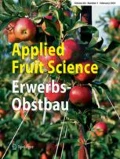Zusammenfassung
Die Postkongress Exkursion des IHC bot einen Einblick in den Kernobstanbau im Granitgürtel am 28° südlichen Breitengrad südlich von Brisbane. Die Kombination von Hügellagen mit Winterkälte und Sommerregen ermöglicht ein gemäßigtes Mikroklima, das nicht nur den Anbau, sondern auch eine Ernteverfrühung von Äpfeln ermöglicht. Kleine Bäume, „Pedestrian orchards“ ohne Einsatz von Arbeitsbühnen, erzielen bei den Standardsorten wie ‚Gala‘, ‚Granny Smith‘ und ‚Pink Lady‘ auf M 26 Erntemengen um 80 t/ha. Hagelschutznetze sind weit verbreitet; die Netze stammen häufig aus Neuseeland, die Pfosten sind Hartholz-Eucalyptusstämme aus Buschrodungen; Honigbienen (5 Völker/ha) – Australien ist Varroa frei- werden unter dem Hagelschutznetz zur Bestäubung der Apfelblüten eingesetzt. Alternanz ist kein Problem. Automatisierung und Mechanisierung spielen bei einem gesetzlichen Mindestlohn von € 14/h in der Obstbauforschung eine große Rolle sowie der prognostizierte Verlust an winterlichem Kältereiz (Chilling). Arbeitskräfte sind Rucksacktouristen vorwiegend aus Europa, auch aus Deutschland; einheimische Kräfte sind aufgrund des hohen Wohlstandes und der geringen Arbeitslosigkeit im Land schwer zur Arbeit auf dem Feld zu bewegen. Nachhaltigkeit und Carbon Footprint spielen auch deshalb eine große Rolle in einem Umfeld mit hohen Kosten, hohen Preisen, aber auch hohen Umsätzen. Australien ist offiziell frei von Feuerband. Dies ist häufig ein Streitpunkt bei Apfelimporten aus Neuseeland.
Abstract
The post congress excursion of the IHC in Brisbane provided insights into the pome fruit industry in the granite belt. The combination of the granite hills with sufficient winter chilling and summer rain provides an unusual temperate zone microclimate despite the subtropical 28°S latitude, which enables the earliest apple harvest in Australia. The major apple cvs ‘Gala’, ‘Granny Smith’ and ‘Pink Lady’ on M26 yield at least 80 t/ha on average in pedestrian orchards, which waive the need for platforms. Alternate bearing is not a problem. Hail nets are widespread (90 %), the netting often originates from New Zealand, the posts from ‘gum trees’ (hardwood Eucalyptus) in local clearings in dry sclerophyll forests; honey bees are used to pollinate the apple trees. The legal minimum wage of € 14/h is often exceeded; farm workers are backpackers visiting mostly from Europe including Germany, who earn their travel money. Local farm workers are difficult to recruit in an environment of low redundancy rate. Sustainability and carbon footprint score high in such a prosperous environment. Australia is officially free of the Varroa mite and fireblight, the latter often a cause for the dispute about apple imports from NZ.










Literatur
Balmer M (2015) Exkursionsbericht: Süßkirschenproduktion in Australien. Erwerbs-Obstbau 57: 00-00 (im Druck)
Blanke MM (2012) Farbige Hagelnetze: Ihre Netzstruktur sowie Licht- und UV-Durchlässigkeit bestimmen die Ausfärbung der Früchte. Erwerbs-Obstbau 49(4):127–139 (Springer Heidelberg)
Blanke MM (2015). Out-of-season Erdbeeren aus Australien. Spargel & ErdbeerProfi 1/2015:68–70.
HAL (2008). Horticulture Industry Carbon Footprint Scoping Study. HAL- Horticulture Australia Ltd., Department of Primary Industries – DPI, Victoria, Australien
Schaefer F, Blanke MM (2014) Opportunities and challenges for carbon footprint, climate or CO2 labels for horticultural products – Nachhaltige Kennzeichnung klimafreundlicher Lebensmittel. Erwerbs-Obstbau 56(2):73–80.
Solomakhin A, Blanke MM (2010) Can coloured hailnets improve taste (sugar, sugar: acid ratio), consumer appeal (colouration) and nutritional value (anthocyanin, vitamin C) of apple fruit. Food Sci Technol-L W T 43:1277–1284.
Tree Fruit (2015a) Sunburn. Part 3. Fruit protection with spray-on, shade netting and evaporative cooling can help reduce sunburn during heatwaves. – Australische Beratungsbroschüre für Baumobst, Ausgabe Januar 2015, Seite 5
Tree Fruit (2015b) Sunburn. Part 5: Fruit protection with spray-on, shade netting and evaporative cooling can help reduce sunburn during heatwaves – Australische Beratungsbroschüre für Baumobst, Ausgabe April 2015, Seite.4
Author information
Authors and Affiliations
Corresponding author
Rights and permissions
About this article
Cite this article
Blanke, M. Exkursionsbericht: Kernobstanbau in Australien. Erwerbs-Obstbau 57, 165–170 (2015). https://doi.org/10.1007/s10341-015-0248-4
Received:
Accepted:
Published:
Issue Date:
DOI: https://doi.org/10.1007/s10341-015-0248-4
Schlüsselworte
- Australien
- Kernobst
- Apfel
- Carbon Footprint
- Eucalyptus
- Feuerband
- Hagelschutznetz
- Mindestlohn
- Nachhaltigkeit
- Schorf
- Varroa-Milbe

